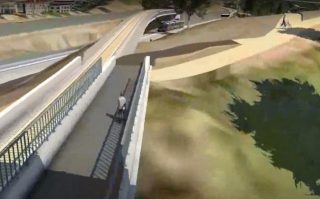
A $206 million project that will improve service on TriMet’s Red light rail line will also come with significant benefits to bicycle riders.
The “Better Red” project will extend the Red Line further west in Washington County; but what we’re watching closely is how the improvements will impact the I-205 path in east Portland.
According to TriMet, the project will add a second track on two sections of existing single track between Gateway Transit Center and the Portland Airport. Adjacent to these new tracks and stations, TriMet plans to build multi-use paths. The project will also re-align the existing path.
Near the airport, a new path will be built from the PDX terminal to NE Air Cargo Road. The Air Cargo Road path will dump riders onto surface streets. (If you want to get to the I-205 path you’ll have to sleuth a route on a mix of streets, sidewalks, and paths until we get a path that connects all the way through.) Near the Gateway Transit Center (NE Halsey and 99th Ave) a new station will come new path and a direct connection to Gateway Green Bike Park via a new bridge over I-84. The existing path with will be re-aligned. (See images below.)
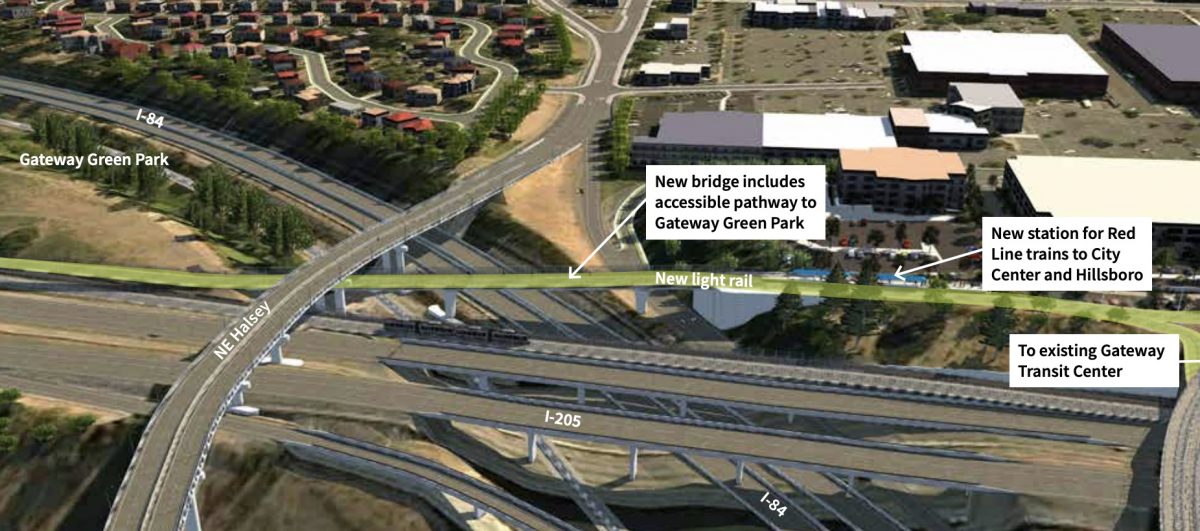
Advertisement
Design of the project is currently underway and it’s scheduled to break ground next year. TriMet says it’ll open in 2024. (By that time, major updates to Gateway Green will be complete. Portland Parks & Recreation is working on Phase 2 updates now and the park has been closed since March.)
To learn more about Better Red, the project is on the agenda of next week’s PBOT Bicycle Advisory Committee meeting. You can attend the meeting online via Zoom starting at 6:00 pm Tuesday, July 14th. Full details on the BP Calendar.
UPDATE, 7/14: TriMet just shared new visuals of the bike path connection to Gateway Green at the monthly PBOT Bicycle Advisory Committee meeting. Check them out below…
— Jonathan Maus: (503) 706-8804, @jonathan_maus on Twitter and jonathan@bikeportland.org
— Get our headlines delivered to your inbox.
— Support this independent community media outlet with a one-time contribution or monthly subscription.


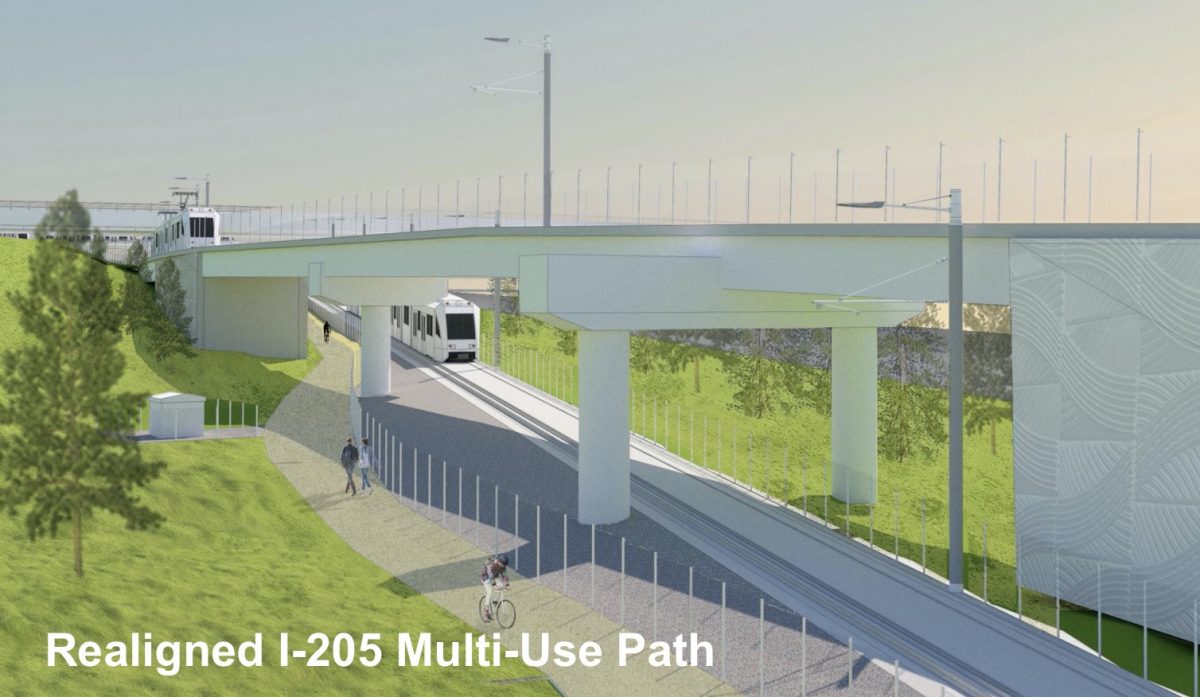


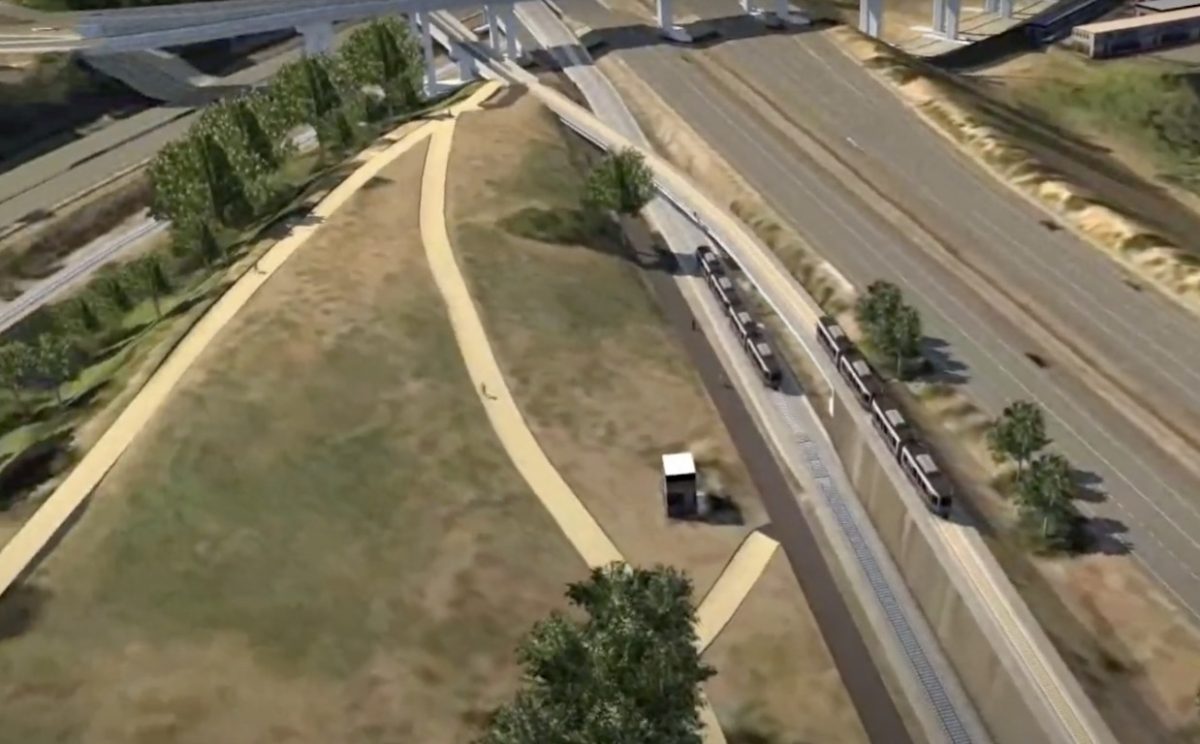
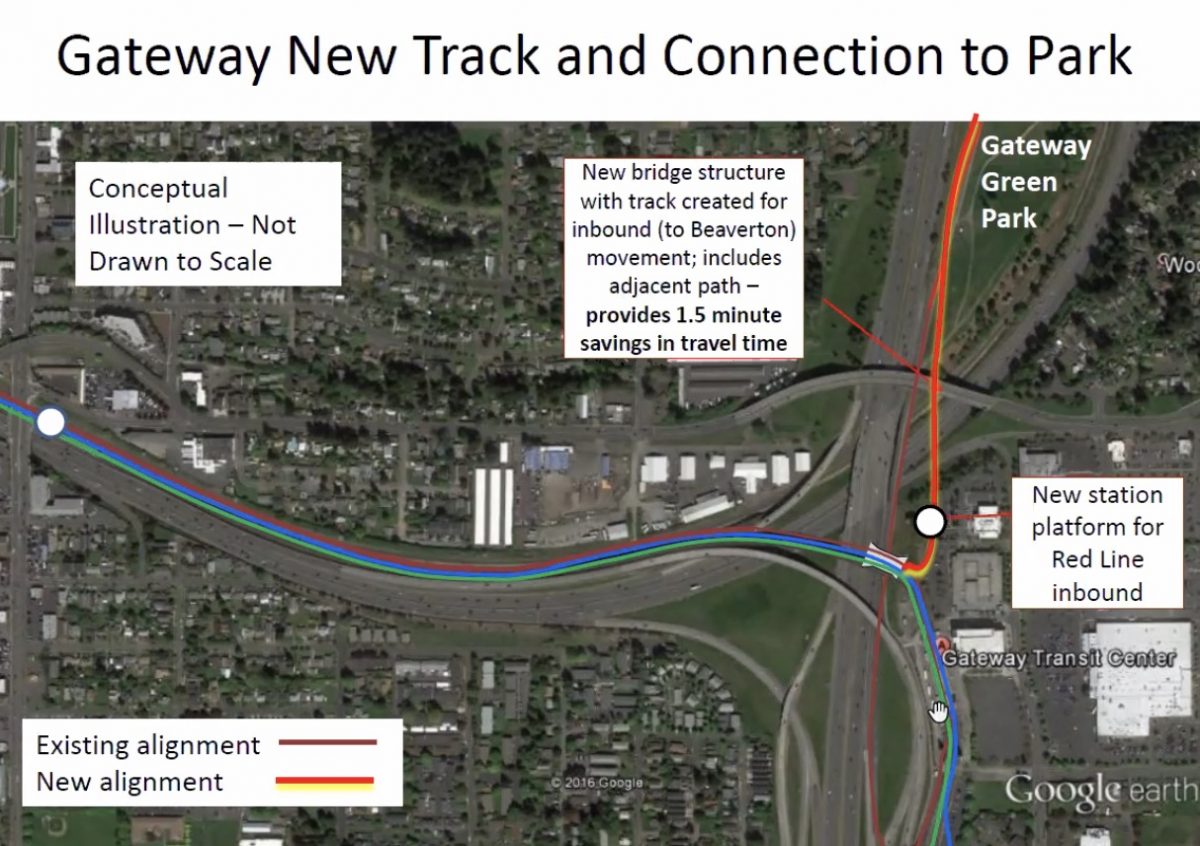
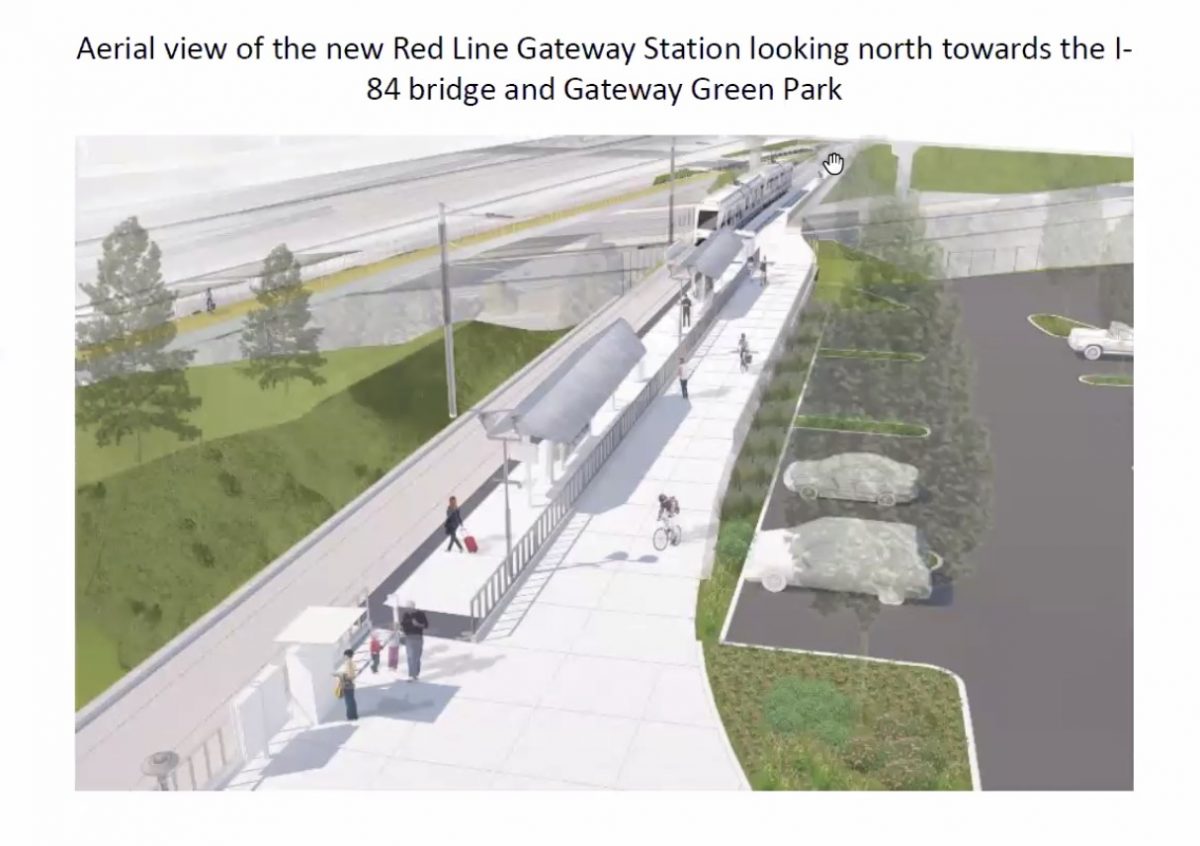
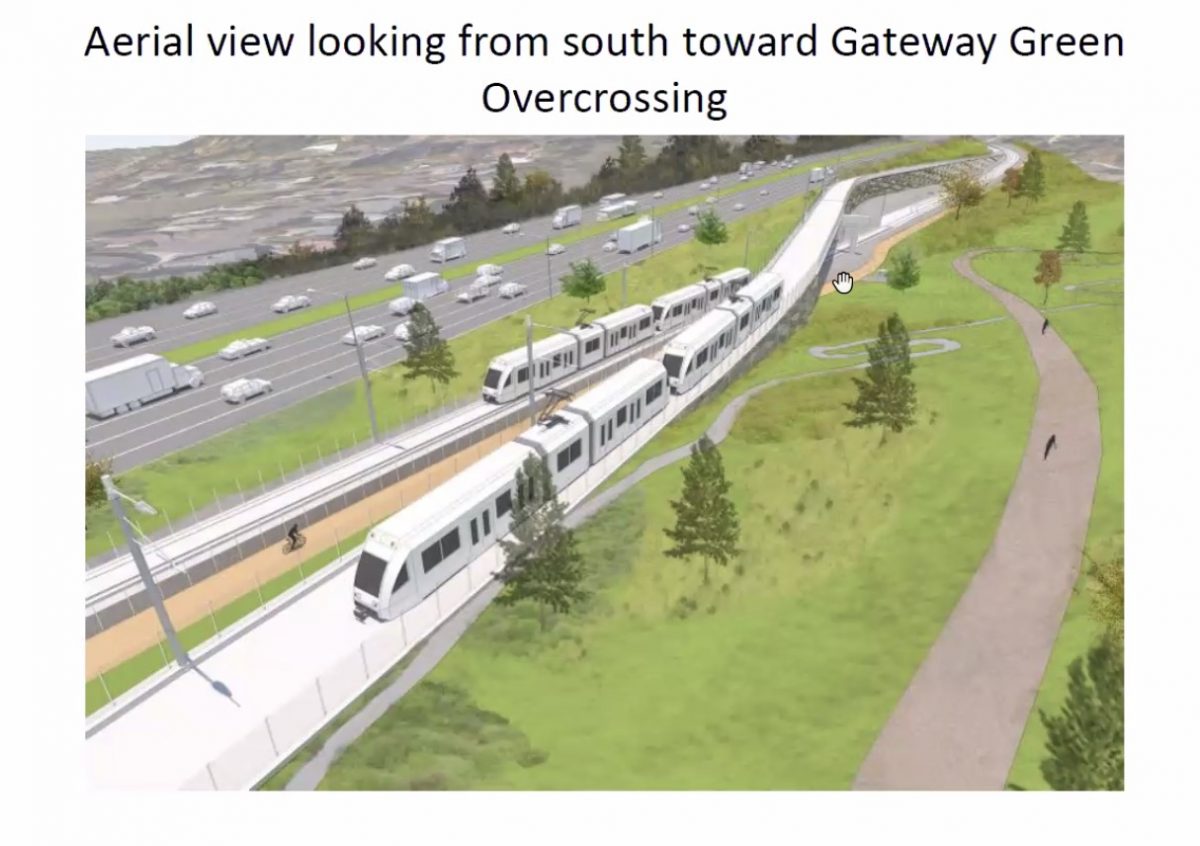
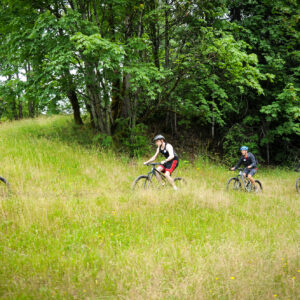
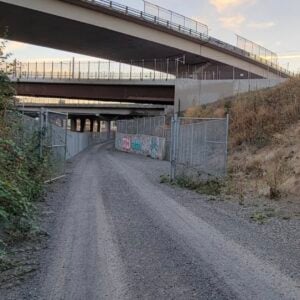
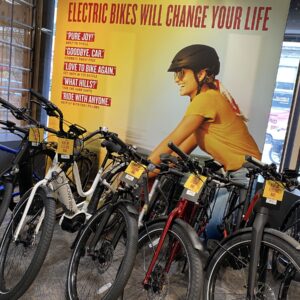
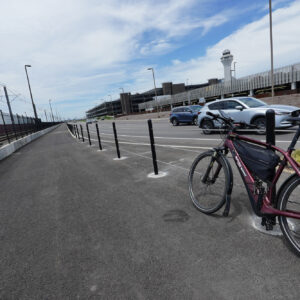
Thanks for reading.
BikePortland has served this community with independent community journalism since 2005. We rely on subscriptions from readers like you to survive. Your financial support is vital in keeping this valuable resource alive and well.
Please subscribe today to strengthen and expand our work.
I was hoping that the new path might be one of the two that the Gateway Green boosters have been hoping for-
connecting to 92nd on the SW side of Gateway Green or
connecting to 102nd on the NE side of Gateway Green
However this new path will still be useful for some and is a welcome change to TriMet’s normal mode of building bridges wide enough for trains/buses but not pedestrians/bikes.
Thanks, TriMet!
One day a Sullivan’s Gulch/I-84 bike trail will link to the SW side of Gateway Green. Someday (some decade?)
My understanding the trail connection to 92nd via NE Hancock and then to the Tillamook Greenway is still in the works.
I hope Trimet’s Better Red project has the foresight to add secure ‘Bikestation’ like secure bike parking + commuter facilities at the Hillsboro station (with the Transit Operators’ relief facility).
Plus how about better integration of the Airport MAX station with the Alaska regional terminal wing (add direct access to checkin and TSA from the MAX platform (its right on the other side of the wall) vs. the long 10 minute boomerrang walk.
Otherwise its another missed opportunity…
Good suggestion, Todd. I’m not yet an expert on airport layout and traffic flow, but I suspect it is more difficult than we would like to add another point of entry and TSA screening area.
Have you asked TriMet yet about any potential BikeSPA plans for the airport?
That Alaska wing has closed and been, or is to be, demolished, with flights being moved to the new extension on the other side of the airport. The removal of it allows room for more second track on the Red Line.
Plus, I’m not sure there would be space down there for check-in and security if things were staying.
I thought I had heard that. Thanks for the clarification. I know that Southwest is moving into the new E Concourse. I couldn’t remember if that causes a domino effect to get Alaska out of their temporary home.
Terminal A is gone forever, and Terminal B is being rebuilt now. Better red will double-track the line all the way to the airport station, but the station will stay in the same place.
Also, there are plans to completely rebuilt the central terminal at PDX, which will eliminate the pre-security shops and restaurants and replace them with an expanded central TSA point to serve the entire airport.
https://www.columbian.com/news/2019/apr/14/portland-international-airport-preparing-for-takeoff/
Cool new camp sites!
TBH the city needs to treat our residents living outside as the biggest problem on their plate. Free keys to an apartment, no questions asked, for anyone who is homeless.
Please don’t try to tell me that denying them this is, in so many words, for their own good.
Isn’t the figure now at like 2,500 people sleeping outside every night? What the fuck!
Why stop with the homeless? How about free apartments for anyone not making over 100k?
Maybe because the point is to get people off the streets and not subsidize those already able to afford a home? Its amazing how people feel aggrieved over not getting a cut of any aid offered to more vulnerable individuals. The cost of housing the majority of folks on the street (some choose to be there via mental/physical issues, I acknowledge that) is simply cheaper than having them on the streets. Its worth the investment.
This is a very cool and very good faith argument.
You are welcome to pay for those who choose not to work. Don’t bill me and please pick up their garbage while you are at it! Free apartments? Are you high? The illegal camping has ruined Portland. C,G, or A, NOBODY RIDES FOR FREE!If getting loaded is more important than everything…Bike paths are for bikes, not garbage and poor decisions. How about the underpass on SE Powell? That’s not okay and it did not exist here 250,000 people ago.
Sad, this was my initial response too. We can’t even dream of something nice because we know what will come.
it’s called the Finland housing first model, you don’t even have to dream, it’s a solvable problem.
I love the new bike facilities, but it is interesting how in a few months time we have gone from increasing capacity on rail transit to the bustling airport being a timely and important thing, to what it seems now, something of an anachronism in the time of Covid-19. How quickly air travel for the masses is becoming a thing of the past.
Yep, ‘Better Red’, than Dead”, ‘dead’ as not spending federal funds to help the COVID19 economy…expect to see more”on-the’shelf’ projects that made a lot of sense before COVID19 and make less now (or are in need of double checking the ‘problem’ still exists.
During major recessions when less money is coming in for operations, public agencies typically respond by doing more infrastructure projects, especially ones that are already funded by the feds. Expect much the same from ODOT, WaDOT, and PBOT. Expensive transportation projects like this were likely planned several years ago for a 20-year horizon. We’ll have more pandemics, nuclear war, and a massive change of climate before TriMet quits designing transit expansions, ODOT quits designing new highways, and PBOT goes ahead and fixes East Portland without delays and cost overruns.
There’s a substantial difference between justified paranoia based on science and irrational paranoia based on inherent biases against certain forms of transport. From what I’ve seen, there’s lots of evidence this disease is rapidly and efficiently transmitted person-to-person in crowded bars, during church choir practices, and at elder-care group homes, for reasons I don’t understand why and that have yet to be fully explained; however, there’s really no demonstrated evidence that the disease is more easily transmitted on crowded buses, mass transit, or even on airplanes, only that they have unwittingly moved many already sick people many miles to infect others.
The main current alternative to mass transit, to move people in hot/cold/wet weather is to drive single-occupancy automobiles, something that most cities in the US no longer have the capacity to do (and many transit users cannot afford, not even an Uber service). I’ll also point out that by the second year of the Spanish Flu pandemic (1918-20), everyone was back to using crowded public transport again – they learned to adapt. And based upon current transit ridership, our transit users are already adapting to the new reality – numbers may be below what they normally are, but they’ve already doubled from the lows in April.
I rode the Max yesterday for the first time in months. It wasn’t overcrowded but a few people seemed unconscious of space and one guy without a mask was belligerant toward two older people wearing masks, saying among other things “It’s just a flu…” They handled it pretty well, politely stating they didn’t want the flu or whatever it might be.
–waiting for the majority to become the consensus, and for leaders to see the light and fall in line. We can’t expect good decisions from the public while prominent voices from capitals are baldfacedly counterfactual.
Thank you, David, for an excellent post
unfortunately, this has been on the drawing board for years. Millions have been spent planning and designing it.
The so-called Better Red project is a classic case of addressing an operational problem with a project that is expensive and short-sighted. The project should be redesigned so it provides much more benefit to transit riders.
The first problem is that it creates a separate station two blocks away from the existing Gateway station, like we have at the Rose Quarter, so passengers coming from the Airport to east Multnomah County, Gresham, and Clackamas, will now have to take a hike at Gateway. This is also true for anyone catching a bus at Gateway.
The second problem is that the extended service ends at the Washington County Fairgrounds, failing to connect with buses from the Hillsboro Transit Center, including service to Forest Grove. There is no reason not to go to the existing Hatfield Center station at the end of the Blue Line. The ridership is just as heavy west of the Fairplex station, but like any transit line, the loads are smaller as one gets to the end of the line. TriMet is building an unnecessary turnaround facility so that half the trains will not go to the end of the line, where there is already an operator break room.
The third problem is that the Red line carries relatively few people to and from the Airport, yet uses a time slot on the overcrowded Steel Bridge. This means that Blue and Green line service east and south of Gateway can’t be increased until the subway gets built, which won’t be any time soon given that this region wants to pour its next light rail money into a mediocre Southwest Corridor project.
The fourth problem is that there should be bus ramps connecting the Gateway station to the inner shoulders of I-205 north of Gateway, so that C-Tran could run express buses between its existing Vancouver Mall terminal of its “Vine” BRT line, and Gateway. The new single-track rail bridge will block this opportunity. Gateway should eventually be a regional transit hub, with an enclosed station and transit-oriented development.
For the short term, the Red Line should be a frequent shuttle service between Gateway and the Airport. The operating money saved should be spent on increasing Blue line service to the end of the line in Hillsboro. This solves all of the operational problems, without spending $206 million or making Gateway an even worse place than it is now. Ironically, during August, TriMet will be running such a shuttle while the Steel Bridge is closed.
As max operator, I have some insight regarding your thoughts.
The main problem with Gateway is that the inbound Red has to cross over the track for the outbound Blue and Green lines. Any sort of delay can lead to a backup of trains running through Gateway as the time it takes for an inbound Red to travel the single track section and land at Gateway is 2-3 min which does not seem like a lot but is when you are pushing rush hour headways.
The Red being single track out of Gateway and PDX means it has to be timed precisely so as to avoid cutting itself off. Again, nice in theory but impossible in practice.
People are confused about where to transfer to the Red line. This project will make that exponentially worse.
Regarding Hillsboro, they can not extend the Red all the way to Hatfield because there is not enough space for trains to layover and there is no way to add more. Plus, as you pointed out, there is minimal traffic to the end of the line. Fair Complex has a large and underused park and ride facility and already has a large auxiliary track.
Also, anyone know where I can get my hands on this magical iridescent white paint shown extensively in the renderings? Looks lovely.
W.W. Grainger sells it. Rust-olium product called Alumi-NON
@Kittens, I am familiar with the reliability problem at Gateway. A shuttle solves that, and of course the track into PDX should be double track. The solution at Hillsboro is to use “fallback” or “dropback” scheduling, in which trains leave with a new operator shortly after they arrive, and the old operator takes an adequate break and leaves with a new train. This also saves on vehicle requirements.
TriMet staff recommended the shuttle option, but GM Kelsey vetoed the idea. An ideal long-term solution might have grade-separated track crossings, reroute buses so they don’t cross the tracks, have an enclosed station with amenities, etc. The current plan solves the scheduling problem, but is costly, introduces other problems, and is not a long-term solution either.
Shuttles come with their own inherent costs and issues. Since the Feds are extremely generous with our taxes towards funding infrastructure, including buses, the biggest out-of-pocket costs for most transit systems is in hiring, training, and retaining staff, particularly drivers, schedulers, maintenance technicians, and customer support, and eventually paying for their retirement benefits. A small bus shuttle costs Trimet not much less to operate than a full MAX train, but unlike the MAX train, the bus can easily get into crashes with other vehicles (usually it’s the other driver’s fault, but it still costs Trimet quite a lot) as they have to mix with traffic, which also slows them down. For passengers, any transfer of any sort is a severe detriment, and the GM is very aware of this (waiting for the next bus/train is the source of most of their customer complaints.) So I’d say the GM was wise to veto the idea, which likely came from someone who doesn’t use transit.
Shuttle train, not bus. Easier to transfer trains at a single station than walk two blocks between stations, as the “Better Red” would require for PDX passengers headed east, south, or transferring to a bus. Regarding transfers, I recommend reading Jarrett Walker’s tutorial on the subject before jumping to conclusions: https://humantransit.org/2009/04/why-transferring-is-good-for-you-and-good-for-your-city.html
The kind of shuttles Jarrett writes about are those connecting from a minor area such as a neighborhood, shopping mall, or employment center to the main line, be it by bus, subway, or LRT. But in this particular case, the airport is a major trip generator, and politically prestigious as well, which follows a different logic from just moving people efficiently.
I freely admit this design is flawed, but then so is the whole station area, which I used frequently when I lived in Portland for 18 years. The overhead station has been discussed, something similar in configuration to Union Station in DC, and if Portland was a lot bigger of a city (or richer like Seattle), I’m pretty sure it would be implemented. It might be a waste of money building this design now, much like freeways and electronic shifters are, but I think of it as an interim solution that will lead to a better (and much more expensive) long-term solution in 2035.
Even with fallback type operation, there is a need for track space.
In general, flexibility and resilience is key to maintaining rail operations schedule adherence. Gateway, Steel Br and the Red Line all demonstrate what happens when you do not have enough excess capacity. Those three locations are responsible for 70-80% of the system delays (my observation).
If you are having trouble understanding how, take a Steel Br classic: imagine we have a northbound Green Line train, it is 5 min late to Union Station due to a passenger delay. It blocks the southbound Yellow/Orange train through the crossover at the base of the Steel Bridge which leaves that train waiting on the top of the Steel Br. for 4 extra min, which in turn blocks the Blue Line train behind it at Rose Quarter for another 5 min. Not to mention we also blocked a Blue at Old Town for 4 min. All of these trains then enter Gateway and the whole thing multiples again and suddenly we have a train reaching the end of the line 20 min late. And it is all due to not designing the system with enough slack.
The Red was built 10 years ahead of schedule, on the cheap, because Bechtel offered 30% of the funding so they could begin to develop Cascade Station. 20 years later the full bill is coming due. I am surprised TM is not completely redesigning Gateway TC because it is a mess but I suspect it has to do with federal funding mechanisms.
A shuttle is out of the question. I think the unspoken truth is that transfers have become too painful because of the rampant dysfunction on display at places like Gateway and even Beaverton. PDX riders are choicest-of-choice meaning they are not interested in waiting at a transfer point watching trash tumbleweeds and tweakers for 15 min.
The land ownership issues cannot be understated; it’s the biggest constraint on expanding the Gateway station area. It involves at least one other state agency other than TriMet & ODOT (Health & Human Services?), PBOT, PDC, a clinic, Multnomah County, and Fred Meyer’s corporate owner Kroger, as well as numerous overlapping political jurisdictions. A real headache.
It seems a bit classist to call riders leaving PDX and heading west “choicest-of-choice” and unable to walk a few feet across a platform to catch a train, yet with “Better Red,” riders heading east and south will be invited to take a two-block hike from one Gateway station to another. Some folks at AORTA have proposed a better idea that takes the rejected TriMet internal proposal and fleshes it out, including a recommendation for more efficient interlining of routes: https://aortarail.org/site/assets/files/1044/lower_cost_max_service.pdf
During normal times, only about 2,500 people depart PDX each day on MAX. About 10,000 people work at PDX. Ridership could be greater with better service. But this project won’t do that.
“Choice” just refers to people who have other options, not who are more (or less) desirable customers than others. It probably does suggest, however, that you have to work a bit harder to attract and retain them than your captive customers who have fewer alternatives.
So less classist than economist.
Again, when I say “choice” riders I mean they are choosing transit when they have other options available. Many are tourists or citizens of Portland who have traveled many hours, take transit rarely, if ever, and not interested in a detour thorough detox dysfunction vis-a-vis hanging out at a transfer point. This may sound harsh but it is real.
Doug Allen’s initial comment says most everything that needs to be said about this project: a half-baked bandaid to a half-baked solution to a problem that should have been waaaaay down our list of things to address when we were looking for another light rail line to build in the 90s—and a bandaid that has benefits and burdens that are inequitably distributed, to boot.
This kind of myopic focus on solving operational problems with little concern for non-operational consequences is why I got out of engineering.
To solve this problem differently (and I would submit, more appropriately) within today’s given constraints, we need to take on this idea that we should be centering (assumed) perspectives of the handful of riders that travel between the airport and points west in the design philosophy of our transit system. We’ve been chasing this kind of “choice” transit rider with the last 20-30 years of our transit investments and our local and regional transit commute mode share has been frozen at 12% the whole time. The idea of a shuttle is a so-called non-starter because it is apparently more important for this fickle demographic to have a one-seat ride to the airport than it is for us to solve a problem that affects literally every other rider in the system in a way that doesn’t both further complicate the system and its wayfinding and doesn’t significantly degrade service for those heading west from Gateway.
I don’t quite understand how we keep getting solutions so wrongheaded (looking at y’all, Green Line, Orange Line, and Purple Line (aka alignments that at best peripherally serve the most important locations in their respective corridors)) while we have the dude who literally wrote the book on intentional and intelligent transit design in our back yard.
As Kittens said, the full bill is coming due. Are we going to put another drink on the tab and let it ride awhile longer (what happens when we need more frequency on the Blue (or Green) line to the east?) or square up?
TriMet has been “chasing choice riders”?
This is simply not true. Ride the system and see who is using it; clearly not the middle class. Prior to Covid-19, outside of AM and PM commutes, it is the working poor and the homeless.
All these cries of inequality are just virtue signaling and they will probably end up ruining the system for everyone.
Meanwhile commuting by car has gotten cheaper, safer, more comfortable and convenient over the last 30 years. Bus and Rail continue to descend into a self-imposed impotency born of liberal guilt. Demand better, people!
I have ridden recently and do normally but don’t currently because I have a choice, which is my point: the folks on transit now don’t necessarily have a different choice because if they did, they would probably be using it. But transit ridership is down.
So who is not on it?
Findings in King County suggest that because 1) ridership is down most on the lines that run between wealthier areas and downtown (eastside suburbs and north end streetcar suburbs) and 2) ridership is holding more steadily on crosstown lines and those between less wealthy areas (south King County) and job centers that 3) those with other travel options and/or the ability to work from home are doing so; you don’t think a similar exercise performed in Portland would reveal a similar pattern? Other analysis by the Transit App explicitly suggests it is so-called choice riders who are fleeing the system now.
The chasing of the “choice” rider can be seen in the shift in focus to Park and Ride-fed, downtown-centric commuter rail-type solutions that focus on moving people long distances quickly, which didn’t come about because of TriMet’s or Metro’s prescience about gentrification and the suburbanization of poverty; east county was solidly middle class at the time of Blue Line construction; the west side was and still is. These resources could have easily been spread more broadly through increased bus service and priority if the goal was to create a more robust anywhere-to-anywhere network useful outside of commuting (and thus useful to a much larger cross section of humanity).
I’m not sure how you get to virtue signaling here. I am asking that we stop privileging the perspectives of the small number of people we assume need one-seat rides to the airport as we seek solutions for this original operational sin (a result of centering that perspective) and look to a future where the demand on the transit system will be even greater and more multidimensional (more so than a milk run to the airport (or even shuttle operations!!) can accommodate).
Sorry Kittens, I just realized I talked right past one of your points and responded to the (non-existent) point I wanted to respond to instead of the one you actually made. Apologies!
Anecdotally I agree with you that when I hop the MAX to go downtown during off peak, there often appear to be more folks that one might classify as “the working poor and the homeless” than there are at other times. And the Transit App analysis on COVID-related ridership changes I linked to upthread suggests your point about ‘who rides when’ is broadly true—the greatest loss in ridership has happened during peak travel times and among those who have higher incomes and are white.
To say the middle class is “clearly” not riding transit is a significant stretch, but I get where you’re coming from.
TriMet an Portland treat public transit as an amenity for poor people. The environmental design is all about controlling/limiting people instead of welcoming them and making them feel comfortable. It is a classist system by design.
It is in fact both classist and institutionally racist. The ideal public transit system is one that serves everyone equally, where even the rich prefer to use public transit, but in the USA only Washington DC seems to have such unlimited funding. Every other transit system is under severe funding constraints and has to make major policy choices that are in fact openly racist and classist: Do you provide a social service and prioritize serving the poor and connecting “captured riders” from their homes to jobs in the major employment centers? Or do you prioritize tourism, downtown development, and connecting the middle-class “choice riders” to their better-paying jobs?
Portland, Seattle, Victoria BC, and Vancouver BC are several examples of cities that have done the latter – they made very conscious choices to prioritize service for middle-class whites over all other users, way back in 1974. But the vast majority of US cities have their best transit service in their poorest neighborhoods, connecting to universities and industrial employment, with over 80% of their riders being “captured”. “Captured” by the way also includes all walkers and bicyclist who don’t own cars, as well as the vast majority of blacks, Latinx, and immigrants.
The “vast majority” of black and Latino folks in Portland have no alternatives to taking TriMet? Is that actually true? And all cyclists and pedestrians who don’t own cars are “captured riders”?
I suppose that in a reductionist world (like the one we are increasingly becoming), if your institution works better for any group than for another, they are “classist” or “racist” or “whateverist”, even if the reasons for that disparity are beyond your control. For example, if you serve downtown (“rich people”) better than the much more dispersed Columbia Industrial District (“poor people”), you are “classist” even though it is much more difficult, expensive, and inefficient to provide high quality transit service to the industrial area (especially if you need to accomodate all it’s different shifts), and even if the analysis proving xxx-ism (e.g. downtown = rich people) is a bit lacking in rigor.
Actually, TM has been rapidly shifting focus to east of I-205 and will continue to do so into the foreseeable future. The problem is that the denser inner city neighborhoods have gentrified around existing lines. Nothing to do with new transit investments, this was about housing stock and quality of life incentives.
I don’t think you are right, David, about Trimet choosing to serve MC and upper-MC white people ahead of poorer black and brown folk. In SW Portland, we have hardly any bus service, and what we have is infrequent. But when I visit N Portland, I see the #72 bus running every 15 min or better. Same for the lines running in NE and SE. I assume it’s b/c Trimet is responding to high demand east of the river and low demand west of the river.
With all of this in mind, would it have made more sense to bypass Gateway altogether and have the Red line re-routed west of I205 when it dives into the tunnel, following the ramp to westbound I84 to tie in with the main line. This would cut out both the stopping time, slow track and traffic around Gateway. Riders going east or south would switch at 82nd instead.
This would be more expensive, but it seems better operationally, and would cut several minutes off of the travel time from PDX to downtown.
Speaking of efficiencies, how about coupling the Airport Red Line with the Orange Line and making both the downtown circulators, replacing the Green and Yellow lines there? Since PSU will be devoid of students until an effective Covid vaccine is widely available (in 2 years at the earliest, maybe never) with all their classes moving online, the need for transit will be vastly reduced, so wouldn’t using the tourist Red Line make more sense? The Green & Yellow lines could then be coupled as an east-side line only, with transfers to the Blue & Red lines on the Rose Quarter to Gateway, and a vast reduction in the number of trains crossing the Steel Bridge. Might even the number of colors be reduced to just 3?
And about that homelessness problem: how about repurposing the various colleges in Portland? With all classes moved online for the next few years, possibly forever, why do PSU, UP, Reed, etc need so many empty dorms and classroom buildings?
No, because there is no good transfer point west of Gateway. And it would make it even harder for people coming from Clackamas or Gresham area transfer.
The transfer at 82nd couldn’t be easier for people riding MAX. Just cross the platform. It wouldn’t work for those transferring to busses, though. I get that. But ridership on the red line is pretty low already, right? How many actually transfer to busses at Gateway?
TriMet doesn’t do stations as much of the world understands them. They are not there in service to any entity that might need to urinite or defecate because gentlepeople do not require such things??
Since TriMet routes are so expeditious and never require long waits at places distant from public facilities of any kind this is completely reasonable??
What makes things worse is that inbound Red Line trains must travel on the outbound main track for a short distance, with switches moved on either end to accommodate.
A small, but far cheaper, improvement would be to directly connect the Red Line track to the center track: https://www.flickr.com/photos/jmchuff/3132221049/ https://www.flickr.com/photos/jmchuff/3132221067/in/photostream/
Ideally, they would have built it as a “T” junction to begin with, with the Blue/Green Line platforms closer to the turn so the two Gateway stations are as close together as possible.
Jim Howell has suggested adding a fourth track next to the existing Gateway platforms, and then rearranging things so Red Line trains in both directions would stay west of the Blue/Green Line trains and cross over north of the station. The arrivals (I-205 side) bus area would be removed, with buses looping via Multnomah and 99th, laying over on 99th.
This is not really the issue. Regardless of traveling on the same track or simply crossing it, there is a big safety cushion of time required that the track being crossed remain unoccupied. An outbound Blue or Green must wait the same period of time to allow an inbound Red to complete its move into Gateway. These are federal rules I believe.
I disagree, that “hike” is not very far at all. Maybe 1 block? If you cannot walk 500 feet (several minutes) to transfer between transit stations then I really don’t know what to tell you. In most major transit systems in the world, just walking from one train platform to another can be much further. Many subway platforms, for instance, can be longer than that, not to mention going up/down stairs and escalators.
The most important things that Trimet needs to focus on is reliability and punctuality. And really, that is true for any transit system. People won’t ride it if there are delays, cancellations and other issues unless they have no other transportation alternative.
The “hike” is no longer than the transfer distance from MAX to the bus bays at Parkrose.
which also sucks
Once you’ve selected a transit alignment that follows an Interstate, you’ve doomed riders to longer walks for bus transfers. There are very few places where freeway alignments have short bus connections.
“will also come with significant benefits to bicycle riders”
Did I miss it or did you fail to list those benefits?
It looks like the same old thing to me: a path on the side of MAX, and being forced to used a mix of streets and paths. Continue with the same old twisty routing and keep us going into that Gateway Green ditch.
I was hoping they’d raise the ground next to the existing MAX line and make it wide enough so that we get our level path back that we lost when they put the MAX in there and made us go up and down that big hill to the bottom of Gateway Green.
When I saw mention of a bridge I was hoping they’d be building a bridge over the MAX to connect to the old level path that’s still there crumbling away between the MAX and freeway.
To me I don’t see any improvements for cycling being made here.
I enjoy the current bike facilities. although with fallback style service, track space is needed. What makes it worse is that inbound Red Line trains have to ride on the outbound main track for a short distance, with changes shifting on each side so fit.
re D. Hampsten’s comment (my paraphrase) that Portland’s light rail system was built to attract the middle class choice rider, its instructive to note that the first line went to Gresham via Rockwood…hardly middle class…and provides service to good industrial jobs on Swan Island via the 85 Swan Island bus. Same for the Red Line that stops at Parkrose, and for the Green Line that goes to outer SE, and even the Yellow Line to N. Portland in the days when it was still affordable.
Here’s the rub…provide high quality transit to any part of town and you risk fueling redevelopment (some call it gentrification) which raises home prices (good or bad depending), rents (generally not so good), and leads to population turn over or as it is often put…displacement. Make a neighborhood or community more attractive…better transit, a cafe or two, more street trees, and guess what? You attract people. Ask folks in Cully, Lents and Montavilla.
Add a grocery store if you really want things to take off.
East Portland is full of huge grocery stores, just not in the right places. But what you really need is a Trader Joes or a Publix.
Back in 1986 when the Blue Line was built, East Portland was still part of the county rather than the city, and Rockwood wasn’t yet part of Gresham, and both areas weren’t as blighted as they are today; in fact they were considered fairly nice suburbs at that time. But I do agree with you, Portland shouldn’t be in the business of subsidizing poor areas of town at the expense of the middle-class, as it only encourages gentrification and homelessness, like they did to downtown and the inner blighted neighborhoods in the 1970s and 1980s – it should have let them slide into oblivion as they have done for East Portland since 1991, and not push out all the black, Italian and Slavic communities living there.
But to your main point about gentrification: Yes, you are totally correct, it’s a constant struggle for any public agency and jurisdiction – if you provide really nice transportation infrastructure improvements like light rail, subway, or a brand new highly-accessible expressway, the newness of the infrastructure itself will spur new housing and commercial development, pushing up existing rents, making the existing area less affordable for people already living or running a business there. The key is for agencies to recognize that change needs to come to the poorer areas and to actively mitigate for the coming gentrification and involuntary economic displacement of existing residents and small businesses – for example, to provide for subsidized housing and business incubators for lower-middle-class as well as poorer residents and business owners, among numerous other measures – rather than waiting for the inevitable homelessness to magically appear.
Like most US cities, Portland has long had a city agency specifically tasked with dealing the negative impacts of gentrification, for supporting impacted local businesses, and providing subsidized housing to prevent homelessness, but like most cities, it has proven to be incompetent in fulfilling its core mission, partly because it suffers from constant interference from city council: The Portland Development Commission (PDC). The State of Oregon encourages cities to engage in a process of urban neglect followed by sudden transportation investments and rezoning to encourage gentrification, through a tool called tax-increment financing (TIF) – as property values rise, the difference in local taxable value can be removed from other taxing jurisdictions (such as school districts) and used for further transportation or housing infrastructure. Chances are this TriMet project gets part of its funding from the Gateway Urban Renewal Area which PDC manages.
The existing I-205 bike path is too steep to be ADA compliant, so the new bridge over I-84 will provide an accessible route and emergency access from Gateway transit center to Gateway Park. Unfortunately for people with mobility issues, the bridge will end at a gravel road that runs through Gateway Green park, negating the benefits of the new accessible entrance. Also,this bridge is supposed to create an improved bike/ped connection to the airport. Unfortunately, the path through Gateway Green will have a gravel section, AND the bridge and path will not include lighting, so it will NOT be great in the winter or evenings.
I’m really hoping this creates a “proper” connection to Gateway Green. As is right now, you have to go under a couple overpasses with campers and needle bits strewn in the path. It really doesn’t make a good impression on visitors… I’m hoping this new bridge plays well with the planned path from NE92nd and under 205 that also pops up into GG. That one might be a bit scary though.
UPDATE, 7/14: TriMet just shared new visuals of the bike path connection to Gateway Green at the monthly PBOT Bicycle Advisory Committee meeting. Check them out below…
Note that in the bottom image, the path will be gravel- not an accessible material, and it will have no lighting, so not useful if you want to use this path to commute or get to the airport from the Max station
I would just continue to use the paved I-205 trail. It’s parallel to the meandering gravel route for Gateway Green and would be faster.
actually, from a point where Multnomah would intersect the MUP along the tracks to a point north where the new path and the 205 path intersect, the route along the existing 205 path is 1.5 time LONGER that the route across the proposed bridge and down the spine road. In addition, the shorter route will have accessible grades which that stretch of the 205 path does not. By not paving this, they are missing the opportunity to create an accessible route, and by not lighting it they are missing the opportunity to create a direct transportation connection.
This is great. Now if they’d only make a proper connector at the Sandy Blvd/Killingsworth intersection.Too many close calls on my commute including a hit and run last year but zero plans for improvements as it’s ODOT jurisdiction, not PBOT unfortunately….